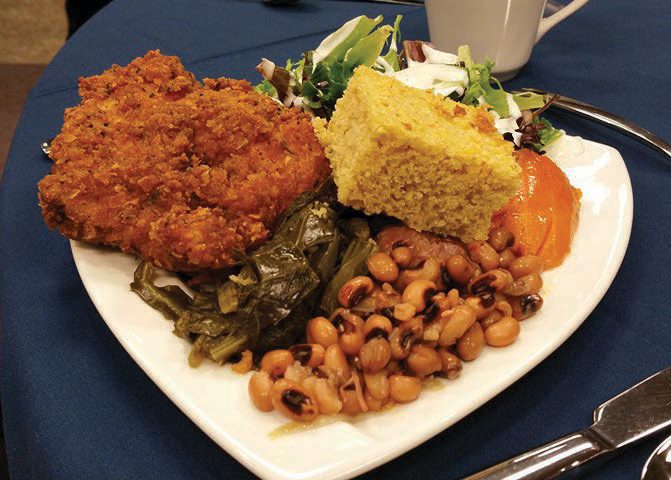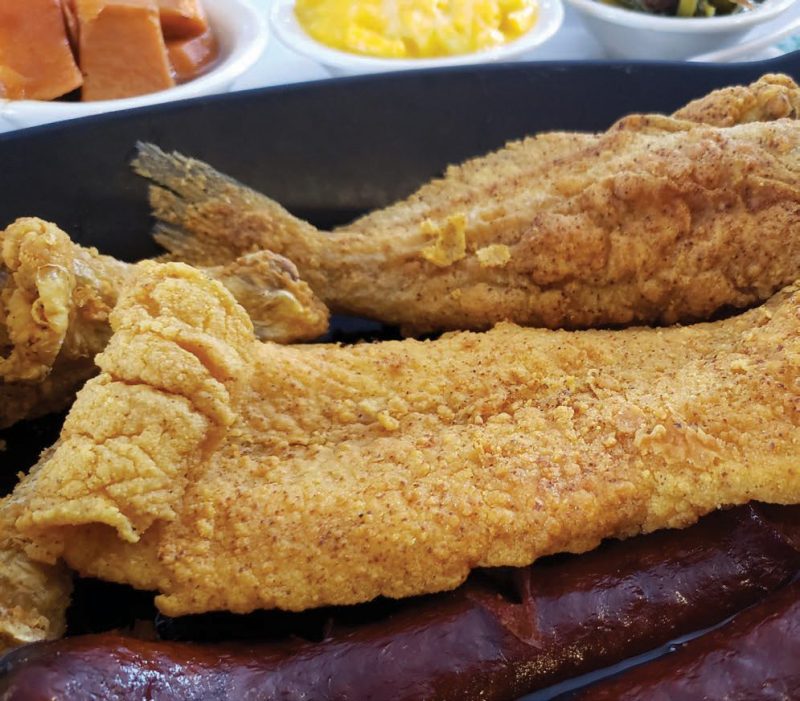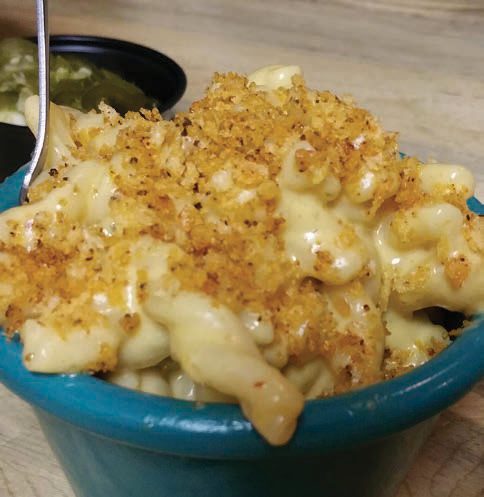This article originally appeared in the Spring 2022 print issue of Quench Magazine.
Soul Food is simultaneously one of the most marketable and misunderstood culinary terms around.
Mention the phrase “Soul Food” to those steeped in, or merely familiar with African American food traditions, and you’ll generate excitement and knowing nods of approval. In my travels around the country and the world, I’ve noticed that the vast majority of people, even the ones who’ve heard about it, don’t really know what Soul Food is. Not to worry, I’m your guide.
Soul Food blends the ingredients, culinary techniques, and traditions of people from West Africa, Western Europe, and the Americas. The seeds for this fusion cuisine were planted when Europeans captured and enslaved hundreds of thousands of West Africans and forcibly brought them to British North America from the 1600s to the 1800s. During the months-long boat trip across the Atlantic Ocean, known as “The Middle Passage,” enslaved captives were initially fed unfamiliar and rotting meat and vegetables from Europe. That maritime diet killed so many enslaved people that slavers started provisioning slave ships with more familiar West African foods like black-eyed peas and rice, groundnuts, okra, and yams.
In colonial British North America, slave-holders tried to control enslaved people’s diet by distributing a certain amount of food on a weekly basis. These controlled amounts of food were called “allotments,” “allowances,” or “rations.” Rations usually included five pounds of a starch (cornmeal, rice or sweet potatoes), a couple pounds of dried, salted or smoked meat (usually pork, but it could be beef or fish), and a jug of molasses. Other-wise, enslaved African Americans survived by supplementing their diet through fishing, foraging, gardening and hunting during their leisure time.

Roaming Buffalo mac ‘n’ cheese 
Fried catfish
In suitable climate conditions, the enslaved grew familiar foods from West Africa like black-eyed peas, millet, okra, sesame seeds, sorghum, and watermelon. Additionally, they substituted the foods that Europeans and Native Americans introduced to them like collard greens, corn (maize), pork, and sweet potatoes. The primary sources of protein were chickens, pigs, seafood, and wild game. Pigs and chickens were popular choices for meat because those animals were easy to raise and thus plentiful. It was during slavery that what would eventually be called Soul Food took shape.
Enslaved people’s diets varied depending on whether they were situated in cities, small farms, or large plantations. On the large plantations, a team of enslaved cooks prepared food for those working in the fields while another team of enslaved cooks fed the slaveholders family in their dwelling, which was usually called “the Big House.” What enslaved people ate on the large plantations has drawn the most attention from historians, so let’s focus there. Generally, enslaved people had a breakfast of crumbled up cornbread mixed with buttermilk. The midday meal, called dinner or lunch in the nineteenth century, consisted of seasonal and locally-grown vegetables that were boiled with some spices and flavored with a small piece of pickled, salted, or smoked meat. In the evening they had “supper,” which was usually just left-overs from the midday meal. The enslaved often ate from troughs and without utensils because the latter were potential weapons and slaveholders constantly feared a slave insurrection.
On weekends and special occasions if slaveholders felt generous and the work schedule slowed down, enslaved cooks got access to more refined and prestigious in-gredients like coveted cuts of meat (ham and pork shoulders), white flour, and white sugar. With these ingredients, they made things that would later become iconic dishes, things like barbecue, biscuits, fried chicken, macaroni and cheese, and sweet potato pie.
From this mix of mundane and celebration food during slavery the most recognizable expressions of Soul Food took shape.
The Soul Food linguistic journey rivals the fascinating twists and turns of its culinary evolution. Before there was Soul Food, any food made in the American South–regardless of class, place, and race–was called “southern cooking.” After Emancipation, large numbers of African Americans left the South for better opportunity in other parts of the U.S., in what is described as “The Great Migration.” As they took their food traditions with them, the migrant cuisine was first labeled “Down Home Cooking,” reflecting a longing for the places where they grew up. It wasn’t until the 1950s and 1960s, that African Americans race consciously divorced their food traditions from others in the region. This was part of a broader effort by Black Power advocates to reinforce cultural ties between Blacks spread across the country. Soul Food was born as a culinary expression associated with what African Americans cooked and ate, and “southern food” became associated with whites.
This was news to white southerners who had eaten the same foods for centuries, but nonetheless, the culinary separation took hold. We’re still living with that legacy today, and a vibrant discussion of “culinary justice” has arisen to address how to reintegrate African American contributions into the southern food story. I often get asked the difference between Soul Food and southern food, and my short, snarky answer is that “Soul Food tastes better.” When pressed to elaborate, I happily explain that some distinctions emerged over time between Soul Food and southern food. The former tends to be more seasoned, rely more on variety meats, and blur the lines between savory and sweet than the latter.

Today, Soul Food has a lot of variety, but there are traditional favorites that make up a typical meal. The entrée could be fried chicken, fried catfish or some sort of pork (chitterlings, ham or a pork chop). The side dishes include any combination of stewed black-eyed peas, candied sweet potatoes, stewed greens (cabbage, collards, kale, mus-tard, turnip greens, in particular), baked macaroni and cheese, and rice. Soul food breads can be either corn-based or wheat-based, and a hot sauce made with cayenne pepper, spices and vinegar is the condiment of choice. Soul Food aficionados often wash their meal down with a sweet beverage that has a red or purple color, respectively referred to as “red drink” and “purple drank.” The most popular soul food desserts are banana pudding, peach cobbler, pound cake, and sweet potato pie.
In addition to traditional soul food, new culinary trends have emerged. With the “Down Home Healthy” approach, cooks are more health-conscious by seasoning vegetables and using leaner meats like smoked turkey instead of pork, adding margarine instead of butter, frying with vegetable oil instead of lard, and using less salt and sugar. The “Upscale Soul” trend reflects how cooks, usually fine dining chefs, use extravagant in-gredients like heirloom vegetables, heritage breed meats, and exotic spices. The most popular and creative of the current Soul Food trends are vegetarian and vegan which avoid the use of meat all together. Vegans take the extra step of prohibiting the use of animal by-products like dairy and honey. Cooks are also experimenting by borrowing ideas from other cuisines to create interesting fusion dishes. Some examples are burritos or egg rolls (known as “soul rolls”) filled with things like collard greens, mashed sweet potatoes, macaroni and cheese, fried chicken with rice and gravy.
Soul Food’s popularity has caused this culinary label to become shorthand for all African American cooking. This is a mistake. Though related, the Creole cooking of Louisiana and the low country cooking of South Carolina have their own distinct culinary heritage and expression. Soul Food is more aptly described as the food that Black migrants took with them and transplanted in other places. In their new homes, they did what any migrant group does: they tried to recreate home through food. If they couldn’t get the exact same ingredients, they found substitutes, and mimicked new dishes they learned from their new neighbors from other cultures. Soul Food simultaneously condensed and expanded the southern menu, and ultimately became something different than southern food. Soul Food remains a vibrant part of the African American diet, and hopefully, you’ll be able to appropriately celebrate it by cooking and eating its delicious dishes. I promise, your soul and stomach will be satisfied.
Adrian Miller is a food writer and recovering attorney who lives in Denver, Colorado. He served as a special assistant to President Bill Clinton with his Initiative for One America – the first free-standing office in the White House to address issues of racial, religious and ethnic reconciliation. Adrian’s first book, Soul Food: The Surprising Story of an American Cuisine, One Plate at a Time won the James Beard Foundation Award for Scholarship and Reference in 2014. His most recent book, Black Smoke: African Americans and the United States of Barbecue, was published in 2021 and won the 2022 James Beard Award for the same category. Adrian is featured in the Netflix series High on the Hog: How African American Cuisine Transformed America.
Feature Photo: Nashville Hot Chicken from Lou’s Food Bar in Nashville | Photo credit: supplied


